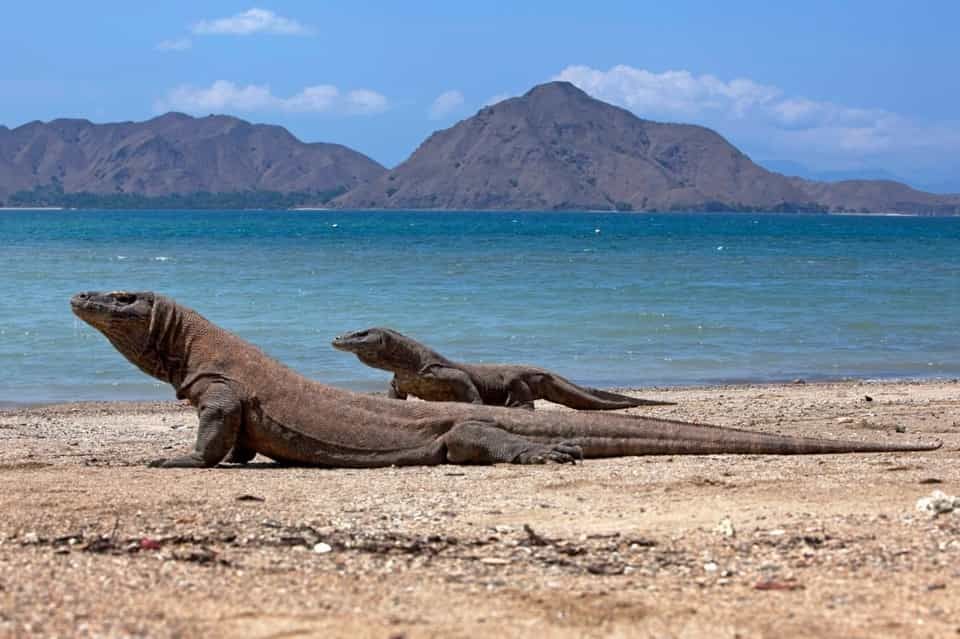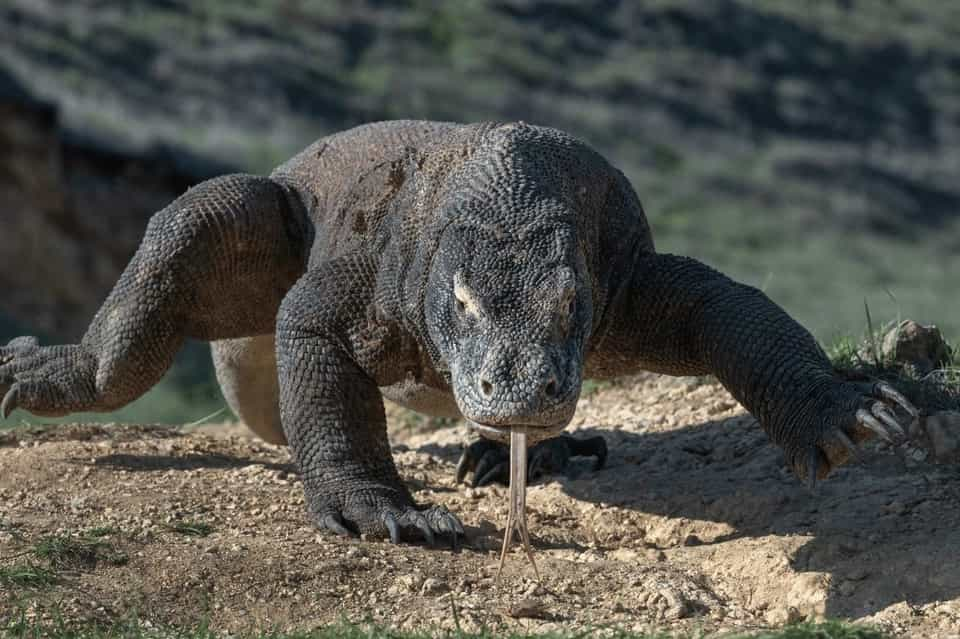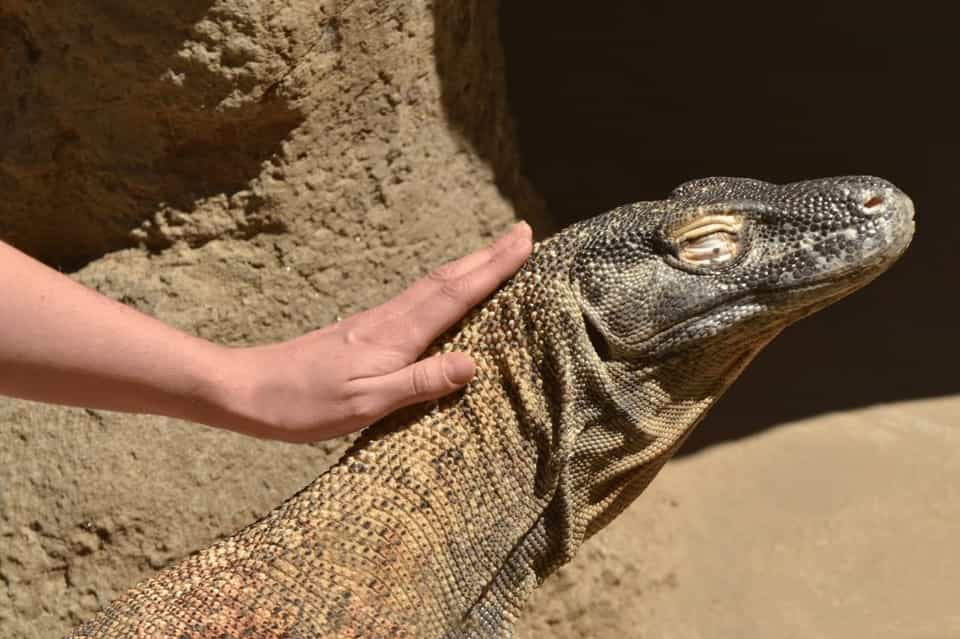Komodo dragons are fascinating and unique animals that are native to the Indonesian islands of Komodo, Rinca, Flores, Gili Motang, and Padar.
Evolution of Komodo’s
Komodo dragons have a rich evolutionary history that dates back millions of years. The genus Varanus, to which Komodo dragons belong, is believed to have originated in Asia around 40 million years ago. Fossil evidence suggests that the first members of this genus were small, arboreal lizards that lived in trees and ate insects.

Over time, some members of the Varanus genus began to evolve larger body sizes and more powerful jaws, which allowed them to consume larger prey. These adaptations likely emerged in response to environmental changes, such as the spread of grasslands and the appearance of new types of prey.
By around 15 million years ago, some members of the Varanus genus had evolved to become terrestrial predators, capable of hunting and scavenging on land. These early Varanus lizards likely played a role in shaping the ecosystems they lived in, as they would have competed with other predators for food and resources.
Around 4 million years ago, the ancestors of modern-day Komodo dragons emerged. These lizards likely originated on an island in Southeast Asia, where they evolved to become larger and more powerful than any other member of the Varanus genus. This evolutionary trajectory likely occurred due to the lack of competition on the island, allowing Komodo dragons to thrive without facing many natural predators.
Today, Komodo dragons remain an important part of the ecosystems in which they live. However, their populations are threatened by habitat loss and hunting, and conservation efforts are necessary to ensure their survival for future generations. The evolutionary history of Komodo dragons is a reminder of the importance of preserving the diversity of life on Earth and the role that every species plays in shaping the natural world.
Behavior
Komodo dragons are fascinating animals with a variety of unique behaviors. Here are some of the most notable aspects of their behavior:

Hunting
Komodo dragons are carnivores, and they use their sharp teeth and powerful jaws to capture and kill their prey. They are known to hunt a variety of animals, including deer, wild boar, and water buffalo. Their venomous bite is a key part of their hunting strategy, as it can cause their prey to become weak and disoriented.
Scavenging
In addition to hunting, Komodo dragons are also known to scavenge for food. They will eat carrion that they come across, and are able to consume large amounts of decaying flesh without getting sick. This allows them to survive during times when hunting is not successful.
Social behavior
Komodo dragons are often thought of as solitary animals, but they are actually social creatures that sometimes form groups. These groups are usually made up of females and juveniles, while adult males tend to be solitary. Social behavior in Komodo dragons is not well understood, but it is thought to play a role in mating and in defending territory.
Basking
Like many reptiles, Komodo dragons rely on the sun to regulate their body temperature. They will often bask in the sun in the morning to warm up, and then move to shady areas during the hottest part of the day to avoid overheating.
Vocalization
Although Komodo dragons are not known for making loud noises, they do communicate with each other through vocalizations. These sounds are usually low-pitched and growling in nature and are thought to play a role in social interactions.
Swimming
Despite their size and bulky appearance, Komodo dragons are strong swimmers and are known to cross open water to reach other islands. They are able to use their muscular tails to propel themselves through the water and can hold their breath for up to 15 minutes.
Understanding the behavior of Komodo dragons is important for conservation efforts, as it allows us to better protect these fascinating animals and the ecosystems in which they live.
Deadliest Venom in the World
Komodo dragons are known for their potent venom, which they use to subdue their prey. The venom is produced in glands located in the lower jaw of the dragon and is delivered through grooves in their teeth when they bite.

The venom of a Komodo dragon contains a complex mixture of toxins that can cause a variety of physiological effects in their prey. These effects include blood loss, organ failure, and paralysis, which can make it easier for the dragon to capture and kill its prey. The venom also contains antibacterial properties, which helps to prevent infection from the bacteria found in the dragon’s mouth.
Despite the deadly nature of the venom, Komodo dragons rarely use it on humans. In fact, there have been very few documented cases of Komodo dragon attacks on humans, and most of these attacks have occurred when the dragon was provoked or felt threatened.
Scientists are still studying the venom of Komodo dragons to better understand its properties and potential medical applications. One recent study found that compounds in the venom may be effective in treating blood clots and preventing strokes, while other research has shown that the venom may have antibacterial and antiviral properties.
While the venom of Komodo dragons can be dangerous, it is also a reminder of the incredible diversity of life on Earth and the important role that every species plays in shaping the natural world. Protecting these unique animals and their habitats is crucial for ensuring their survival and for preserving the biodiversity of our planet.
Reproduction
Komodo dragons reproduce sexually, with males and females coming together for mating. The breeding season for Komodo dragons typically occurs between May and August, with females laying their eggs between August and September.

Males will compete with each other for access to females, with the largest and strongest males typically being the most successful. Once a male has mated with a female, he will typically move on to find other mates.
After mating, females will lay their eggs in nests that they dig themselves. The nests are typically located in sandy soil or compost and can be up to 3 feet (1 meter) deep. Females will lay between 20 to 30 eggs in each clutch, with the eggs taking around 7 to 8 months to hatch.
Once the eggs have hatched, the baby Komodo dragons are on their own, as their mother does not provide any parental care. The young dragons are vulnerable to predators and must fend for themselves, feeding on small insects and lizards until they are large enough to hunt bigger prey.
It is important to note that Komodo dragons are an endangered species, and their reproductive success is vital to their survival. Habitat loss, hunting, and climate change are all threats to the survival of these animals, and conservation efforts are needed to protect them and their habitats.
Human Encounters in the Wild

2001
In 2001, a Komodo dragon attacked a group of tourists in Indonesia, resulting in several injuries. The incident occurred on Rinca Island, which is home to a large population of Komodo dragons. According to reports, the tourists were taking photos of the Komodo dragons when one of the animals suddenly attacked, biting one of the tourists on the leg.
Other tourists attempted to intervene, but the Komodo dragon continued to attack, causing injuries to several people before eventually being driven off. The injured tourists were evacuated by boat to receive medical treatment.
This incident highlights the importance of respecting the space and behavior of wild animals, especially powerful predators like the Komodo dragon. While they may appear docile, these animals can inflict serious harm and should be treated with caution and respect.
2007
In 2007, a group of Komodo dragons attacked two fishermen in Indonesia, resulting in one death and one injury. The incident occurred on Flores Island, where the fishermen had gone to collect seaweed. According to reports, the Komodo dragons approached the men and began to attack, biting them multiple times.
Despite efforts to fight off the animals, one of the fishermen was killed in the attack, while the other sustained serious injuries. The incident highlights the potential danger of interacting with Komodo dragons and the importance of taking precautions when in their natural habitat.
While these animals are a vital part of the local ecosystem, they are also powerful predators and should be treated with caution and respect. Conservation efforts are needed to protect both the Komodo dragons and the local communities that share their habitat to ensure a sustainable future for all.
2009
In 2009, a Komodo dragon attacked a park ranger in Indonesia, resulting in severe injuries. The incident occurred on Komodo Island, where the ranger was working to protect the local population of Komodo dragons. According to reports, the ranger was walking along a trail when he was suddenly attacked by a Komodo dragon, which bit him on the leg and caused serious injuries.
The ranger was rushed to a hospital for medical treatment, where he underwent surgery to repair the damage caused by the attack. The incident highlights the importance of respecting the behavior and space of wild animals, even when working to protect them.
While incidents like this are relatively rare, they serve as a reminder of the potential dangers of interacting with wild animals. It is important for people to take precautions and exercise caution when in the natural habitats of these animals, to ensure the safety of both humans and wildlife.
2017
In 2017, a Komodo dragon attacked a tourist in Indonesia, resulting in serious injuries. The incident occurred on Komodo Island, where the tourist was visiting to see the local population of Komodo dragons. According to reports, the tourist was taking photos of the Komodo dragons when one of the animals suddenly attacked, biting his hand, and causing serious injuries.
The tourist was evacuated by boat to receive medical treatment, where he underwent surgery to repair the damage caused by the attack. The incident highlights the importance of respecting the behavior and space of wild animals, especially powerful predators like the Komodo dragon.
While these incidents are relatively rare, they serve as a reminder of the potential dangers of interacting with wild animals. It is important for people to take precautions and exercise caution when in the natural habitats of these animals, in order to ensure the safety of both humans and wildlife.
